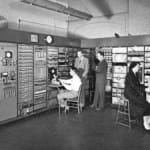
The need for a system capable of true flight simulation was one of the outcomes of World War II, and the Navy commissioned MIT to research and develop one that could help them train bomber crews. After seeing the results of the school’s study, Project Whirlwind was created with Navy funding.
After discovering limitations in the speed of analog machines, a digital computer was conceived after a demonstration of the ENIAC in 1945. Six years later the first computer that could operate in real time and run output on video displays came online April 20, 1951. Up until then computers were fed single instructions prepared in advance and ran them in the common bit-serial mode. The Whirlwind was designed to use bit-parallel mode, vastly increasing it’s computational power over other machines of the time. The Whirlwind was sixteen times faster than other machines of the era.
Today nearly all computer processors use this mode, marking the Whirlwind as one of the grandfathers of the modern computer age. It was a system that made a hugely influential impact on the design of future machines, and eventually led to the development of the U.S. Air Force’s SAGE system, the TX-0 and TX-2, and contributed to nearly every computer and minicomputer of the early 60s and beyond.
